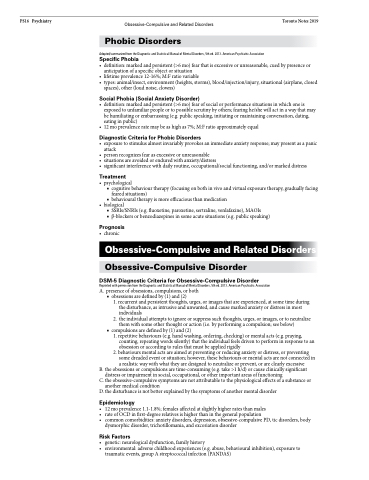Page 1180 - TNFlipTest
P. 1180
PS16 Psychiatry
Obsessive-Compulsive and Related Disorders Toronto Notes 2019 Phobic Disorders
Adopted/summarized from the Diagnostic and Statistical Manual of Mental Disorders, 5th ed. 2013. American Psychiatric Association
Specific Phobia
• definition:markedandpersistent(>6mo)fearthatisexcessiveorunreasonable,cuedbypresenceor anticipation of a specific object or situation
• lifetimeprevalence12-16%;M:Fratiovariable
• types:animal/insect,environment(heights,storms),blood/injection/injury,situational(airplane,closed
spaces), other (loud noise, clowns)
Social Phobia (Social Anxiety Disorder)
• definition:markedandpersistent(>6mo)fearofsocialorperformancesituationsinwhichoneis exposed to unfamiliar people or to possible scrutiny by others; fearing he/she will act in a way that may be humiliating or embarrassing (e.g. public speaking, initiating or maintaining conversation, dating, eating in public)
• 12moprevalenceratemaybeashighas7%;M:Fratioapproximatelyequal
Diagnostic Criteria for Phobic Disorders
• exposuretostimulusalmostinvariablyprovokesanimmediateanxietyresponse;maypresentasapanic attack
• personrecognizesfearasexcessiveorunreasonable
• situationsareavoidedorenduredwithanxiety/distress
• significantinterferencewithdailyroutine,occupational/socialfunctioning,and/ormarkeddistress
Treatment
• psychological
■ cognitive behaviour therapy (focusing on both in vivo and virtual exposure therapy, gradually facing
feared situations)
■ behavioural therapy is more efficacious than medication
• biological
■ SSRIs/SNRIs (e.g. fluoxetine, paroxetine, sertraline, venlafaxine), MAOIs
■ β-blockers or benzodiazepines in some acute situations (e.g. public speaking)
Prognosis
• chronic
Obsessive-Compulsive and Related Disorders
Obsessive-Compulsive Disorder
DSM-5 Diagnostic Criteria for Obsessive-Compulsive Disorder
Reprinted with permission from the Diagnostic and Statistical Manual of Mental Disorders, 5th ed. 2013. American Psychiatric Association
A. presence of obsessions, compulsions, or both ■ obsessions are defined by (1) and (2)
1. recurrent and persistent thoughts, urges, or images that are experienced, at some time during the disturbance, as intrusive and unwanted, and cause marked anxiety or distress in most individuals
2. the individual attempts to ignore or suppress such thoughts, urges, or images, or to neutralize them with some other thought or action (i.e. by performing a compulsion; see below)
■ compulsions are defined by (1) and (2)
1. repetitive behaviours (e.g. hand washing, ordering, checking) or mental acts (e.g. praying,
counting, repeating words silently) that the individual feels driven to perform in response to an
obsession or according to rules that must be applied rigidly
2. behaviours mental acts are aimed at preventing or reducing anxiety or distress, or preventing
some dreaded event or situation; however, these behaviours or mental acts are not connected in
a realistic way with what they are designed to neutralize or prevent, or are clearly excessive
B. the obsessions or compulsions are time-consuming (e.g. take >1 h/d) or cause clinically significant
distress or impairment in social, occupational, or other important areas of functioning
C. the obsessive-compulsive symptoms are not attributable to the physiological effects of a substance or
another medical condition
D. the disturbance is not better explained by the symptoms of another mental disorder
Epidemiology
• 12 mo prevalence 1.1-1.8%; females affected at slightly higher rates than males
• rate of OCD in first-degree relatives is higher than in the general population
• common comorbidities: anxiety disorders, depression, obsessive-compulsive PD, tic disorders, body
dysmorphic disorder, trichotillomania, and excoriation disorder
Risk Factors
• genetic: neurological dysfunction, family history
• environmental: adverse childhood experiences (e.g. abuse, behavioural inhibition), exposure to
traumatic events, group A streptococcal infection (PANDAS)


